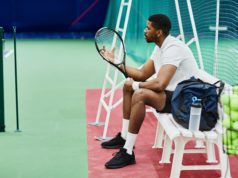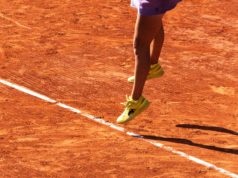By Erica Zabkar, Director, Universal Tennis Academy
Think of any sport: Football, baseball, basketball, soccer, etc. Teams with a strong defense often are more competitive, and great defensive players are of incredible value to a team. Tennis has an important defensive component as well. All tennis points are comprised of a combination of three phases: offense, neutral, and defense. Oftentimes, as coaches, we tend to focus on the offensive and neutral phases but improving your defensive skills can help you stay competitive in matches and may even help secure a challenging win. Below are three defensive components to develop in your game:
The “Physical”: We might not have the luxury of off-court training like the pros, but speed and anticipation are a major benefit to good defensive tennis. The first step is predicting where your opponent will go with the shot. Over time, it becomes less of a guess as you learn to read your opponent. This is especially important to defensive tennis in the doubles game. Second, is having a well-timed and proper split step. This will lead to an explosive first step to help chase down any shot. A proper split occurs as your opponent is striking the ball and needs to be wider than your shoulders while landing on the balls of your feet.
The “Reset Ball”: The reset ball can come in different forms, but it is a shot used to get back in the point to at least the neutral phase. My shot of choice, particularly when stretched out wide, is the defensive lob. Using a continental grip, the objective is to lift the ball up high to give yourself time to get back in the court. Now, if your opponent takes your lob and stays aggressive with their next shot and hits a winner, then simply say “good shot.” You did your job in making them hit an extra ball. Other reset options include a slice or a higher, heavy topspin ball. Work on different shots to different targets in practice so you’re ready for anything!
“Make good choices”: After the work of anticipating, getting to, and learning the different shots, the final step is deciding where to hit it. As your defensive shot-making improves, you will find you have more control than you think. Knowing the highest percentage shot to hit and what to hit will put you in the best position to get back to neutral and hopefully turn the point in your favor. When stretched out wide, go crosscourt, even aiming more towards the middle. Going crosscourt is over the shortest part of the net, through the longest part of the court, and will minimize your opponent’s angle to the open court. Decision-making also applies to what to hit. There are times when a couple of options will work, so use your favorite. But knowing your positioning, your opponent’s positioning, and the moment in the match should all influence your decision. If you are in control of a match with a big lead, why not have some fun and go for something a little riskier?
There are many aspects of defense but applying the concepts above will be a good start. In doubles, for example, defensive skills may be seen more in reflexing or scooping up tough volleys or blocking back big serves. I say to my teams all the time, “it doesn’t say ‘ugly’ on the scorecard or drawsheet!” What I mean is that sometimes you must scrape and claw and hustle yourself to victory. It’s always fun to hit the ball well and be able to dominate the match, but great defensive skills can help carry you through tough days and get you more wins than you think. So go out and have some fun developing these skills and your shot-making!
USTA GEORGIA-GPTA TEACHING PROFESSIONAL SPOTLIGHT: Erica Zabkar
 Hometown (City/State): Roswell, GA
Hometown (City/State): Roswell, GA
How did you get involved in teaching tennis? I have loved tennis since the moment I took my first tennis clinic. I accepted a graduate assistantship after college and also worked at a local tennis club. I have worked in various roles since, but decided to start teaching full time again in 2016
Diehard fan of what sports team? Green Bay Packers and Atlanta Braves
Best part of your game? Consistency and defensive skills
Dream doubles match would be me and… Queen Elizabeth, Aaron Rodgers, and Dolly Parton.
When I’m not teaching tennis, I’m… Golfing, hanging out with my friends & family, relaxing at home with my dog, Bailey.
My favorite tennis memory is: Winning the 2012 Southern Conference regular season championship while coaching at UNCG!
My favorite professional player is: Roger Federer
#1 reason why I enjoy teaching & coaching tennis: Getting to connect with so many amazing people while helping them achieve their tennis goals.
What important tennis message do you want to promote? It is never too late to start or return to your tennis journey! Tennis truly is a lifetime sport.




